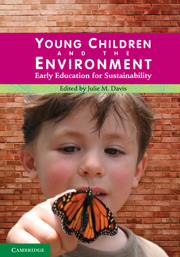Book contents
- Frontmatter
- Foreword
- Contents
- List of contributors
- Introduction
- PART 1
- PART 2
- Chapter 6 Repositioning an ethic of sustainability in early childhood education, with Reconciliation as central
- Chapter 7 The world is flat: ICT and education for sustainability in the early years
- Chapter 8 Healthy and sustainable environments for children and communities
- Chapter 9 Creating deep and broad change through research and systems approaches in early childhood education for sustainability
- Endnote
- Index
- References
Chapter 6 - Repositioning an ethic of sustainability in early childhood education, with Reconciliation as central
from PART 2
- Frontmatter
- Foreword
- Contents
- List of contributors
- Introduction
- PART 1
- PART 2
- Chapter 6 Repositioning an ethic of sustainability in early childhood education, with Reconciliation as central
- Chapter 7 The world is flat: ICT and education for sustainability in the early years
- Chapter 8 Healthy and sustainable environments for children and communities
- Chapter 9 Creating deep and broad change through research and systems approaches in early childhood education for sustainability
- Endnote
- Index
- References
Summary
EDITOR'S NOTE
This is a provocative and challenging chapter. The links between Australia's sustainability issues, Indigenous cultures and Indigenous perspectives on country – both past and present – are clear but complex. Melinda Miller, a non-Indigenous author, challenges those of us working in ECEfS to avoid privileging the environmental dimension of sustainability over social, economic and political dimensions. Miller challenges us to make Reconciliation with Indigenous Australians a central tenet of our thinking and pedagogies in ECEfS work.
Miller asserts that, as the new wave of interest in ECEfS heightens, ECEfS offers a unique opportunity for early childhood educators to put Reconciliation front and centre and, in so doing, contribute to repairing the Earth, the shared but fractured histories of Indigenous and non-Indigenous Australians and creating new and sustainable futures for all Australians.
INTRODUCTION
Sustainability initiatives in early childhood education curricula and contexts have been a new focus of attention in recent years. These initiatives manifest typically as educator or whole-of-setting responses to increased awareness about the fragility of natural environments in local and global contexts. However, concern about environmental conditions is just one dimension of sustainability. As discussed in Chapter 1, the environmental dimension of sustainability sits alongside social, political and economic areas of concern. Collectively, these four dimensions generate an holistic understanding of sustainability, described by UNESCO (2006a) as four interdependent dimensions that require simultaneous and balanced progress (see Figure 0.1).
- Type
- Chapter
- Information
- Young Children and the EnvironmentEarly Education for Sustainability, pp. 185 - 211Publisher: Cambridge University PressPrint publication year: 2010
References
- 5
- Cited by



